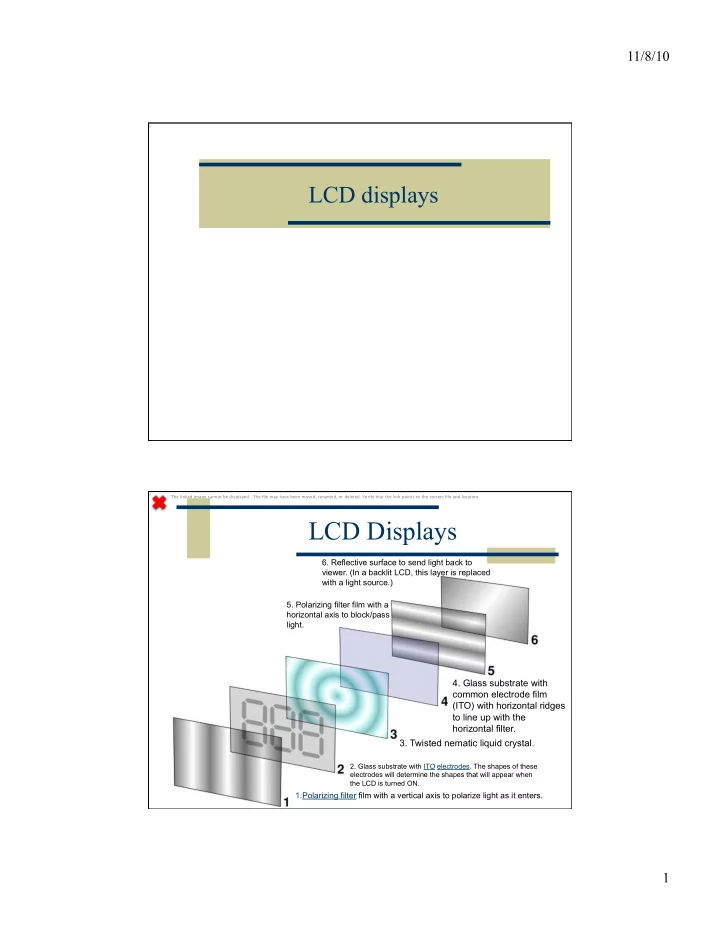

11/8/10 LCD displays The linked image cannot be displayed. The file may have been moved, renamed, or deleted. Verify that the link points to the correct file and location. LCD Displays 6. Reflective surface to send light back to with a light source.) viewer. (In a backlit LCD, this layer is replaced 5. Polarizing filter film with a light. horizontal axis to block/pass 4. Glass substrate with common electrode film (ITO) with horizontal ridges horizontal filter. to line up with the 3. Twisted nematic liquid crystal. 2. Glass substrate with ITO electrodes. The shapes of these the LCD is turned ON. electrodes will determine the shapes that will appear when 1. Polarizing filter film with a vertical axis to polarize light as it enters. 1
11/8/10 LCD Displays Workhorse Displays 2
11/8/10 LCD Advantages Low Power – lots of battery life Lots of pixels are possible Lots of LCD shapes are possible Inexpensive But – LCDs don’t emit light so they need a backlight Form factors One common style is the 2-line 16-character display Almost always uses the same controller Hitachi HD44780 LCD controller chip 4- or 8-bit data interface Need 7-11 pins to drive the interface depending on how it’s configured 3
11/8/10 HD 44780-compatable LCDs HD 44780-compatable LCDs 4
11/8/10 HD 44780- compatable LCDs 5
11/8/10 HD 44780-compatable LCDs Example Timing… HD 44780-compatable LCDs Example Timing… 6
11/8/10 HD 44780-compatable LCDs Example Startup Timing… HD 44780-compatable LCDs 7
11/8/10 HD 44780-compatable LCDs Luckily you don’t have to do all this from scratch! These LCDs are everywhere So, helpful people have put all this stuff into libraries for you One comes with Arduino… LiquidCrystal library LiquidCrystal library Comes built in to Arduino environment LiquidCrystal(), begin(), clear(), home(), setCursor(), write(), print(), cursor(), noCursor(), blink(), noBlink(), display(), noDisplay(), scrollDisplayLeft(), scrollDisplayRight(), autoscroll(), noAutoscroll(), leftToRight(), rightToLeft(), createChar() 8
11/8/10 LiquidCrystal example #include <LiquidCrystal.h> // initialize the library with the numbers of the interface pins LiquidCrystal lcd(12, 11, 5, 4, 3, 2); //RS, En, D4, D5, D6, D7 void setup() { lcd.begin(16, 2); // set up the LCD's number of columns and rows lcd.print("hello, world!"); // Print a message to the LCD. } void loop() { // set the cursor to column 0, line 1 // (note: line 1 is the second row, since counting begins with 0): lcd.setCursor(0, 1); // print the number of seconds since reset: lcd.print(millis()/1000); } LiquidCrystal issues Barebones LCD displays are pretty cheap 16-char, 2-line LCD from Sparkfun: $14.95 Even cheaper from surplus places But, uses a lot of digital pins… Solution: Use a helper chip to convert to a serial interface Uses only one wire (plus vdd and gnd) 9
11/8/10 Serial LCD Serial protocol Only one TX wire Takes longer to upload data to the LCD But, still happens very fast to our eyes… More expensive… Sparkfun: $24.95 SparkSoftLCD Serial LCD Library Download from the “Playground” Print(), begin(), clear(), backlight(), enable(), scroll(), cursor(), cursorTo(), moveCursor(), sendControl() 10
11/8/10 SparkSoftLCD Example #include "SparkSoftLCD.h" � #define LCD_TX 2 � #define LCD_WIDTH 16 � SparkSoftLCD lcd = SparkSoftLCD(LCD_TX, LCD_WIDTH); � void setup() { � pinMode(LCD_TX, OUTPUT); lcd.begin(9600); // leave at 9600 unless you change the baud rate of the lcd | � lcd.clear(); � } � void loop() { � lcd.print("Testing 1 2 3"); � delay(1000); � lcd.clear(); � float x = 5.14; // print a floating point number with two decimals � lcd.print(x, 2); � delay(1000); � lcd.clear(); � } Other LCDs Graphic LCDs Pixel programmable rather than characters 128x64 for example Harder to use ~$35 Color LCD displays E.g. OLED 128x128 ~$60 E.g. Nokia 6100 ~$35 11
11/8/10 LCD Conclusions Standard 16-char 2-line LCDs are easy to use “bare bones” with Hitachi HD44780 controller 7 or 11 pins needed – built in LiquidCrystal library Serial-enabled LCD Only one pin needed SparkSoftLCD library in the playground Graphic LCDs – a little harder to use… Lots of other surplus versions Some easier to use than others… 12
Recommend
More recommend